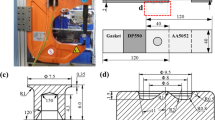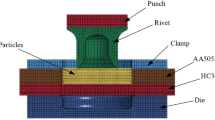Abstract
To facilitate the die selection for new self-piercing riveting (SPR) joint configurations, it is necessary to find out how the critical die geometric parameters influence the SPR process. In this study, a two-dimensional (2D) axisymmetric simulation model was developed to numerically study the riveting process. The influences of the die type, the die diameter, the die depth, and the die pip height on the deformation behaviour of the rivet and sheets were systematically studied. Moreover, the flared rivet shank radius and the thickness at the centre of the bottom sheet during the SPR process were first monitored using the developed simulation model. The simulation results revealed that these die parameters have significant influences on the deformation behaviour of the rivet and sheets. The flared rivet shank radius showed an increasing trend with the increment of the die diameter and the die pip height, while it decreased with the increment of the die depth. Furthermore, it was also found that the flaring speed of the rivet shank depended heavily on the filling condition of the die cavity underneath the rivet cavity. A rapid flare of the rivet shank was observed when this space was fully filled.


































Similar content being viewed by others
References
Han L, Thornton M, Shergold M (2010) A comparison of the mechanical behaviour of self-piercing riveted and resistance spot welded aluminium sheets for the automotive industry. Mater Des 31:1457–1467
Huang Z, Yao Q, Lai J, Zhao J, Jiang Z (2017) Developing a self-piercing riveting with flange pipe rivet joining aluminum sheets. Int J Adv Manuf Technol 91:2315–2328
Kochan A (2000) Audi moves forward with all-aluminium cars. Assem Autom 20:132–135
Mortimer J (2001) Jaguar uses X350 car to pioneer use of self-piercing rivets. Ind Robot An Int J 28:192–198
Li D, Chrysanthou A, Patel I, Williams G (2017) Self-piercing riveting-a review. Int J Adv Manuf Technol 92:1777–1824
He X, Xing B, Zeng K, Gu F, Ball A (2013) Numerical and experimental investigations of self-piercing riveting. Int J Adv Manuf Technol 69:715–721
Li D, Han L, Lu Z, Thornton M, Shergold M (2012) Influence of die profiles and cracks on joint buttons on the joint quality and mechanical strengths of high strength aluminium alloy joint. Adv Mater Res 548:398–405
Ma Y, Lou M, Li Y, Lin Z (2018) Effect of rivet and die on self-piercing rivetability of AA6061-T6 and mild steel CR4 of different gauges. J Mater Process Technol 251:282–294
Mori K, Abe Y, Kato T (2007) Finite element simulation of plastic joining processes of steel and aluminum alloy sheets. AIP Conf Proc 908:197–202
Abe Y, Kato T, Mori K (2008) Self-pierce riveting of three high strength steel and aluminium alloy sheets. Int J Mater Form 1:1271–1274
Jäckel M, Falk T, Landgrebe D (2016) Concept for further development of self-pierce riveting by using cyber physical systems. Procedia CIRP 44:293–297
Drossel WG, Jäckel M (2014) New die concept for self-pierce riveting materials with limited ductility. Key Eng Mater 611:1452–1459
Landgrebe D, Jackel M, Niegsch R (2015) Influence of process induced damages on joint strength when self-pierce riveting carbon fiber reinforced plastics with aluminum. Key Eng Mater 651:1493–1498
Hoang NH, Porcaro R, Langseth M, Hanssen AG (2010) Self-piercing riveting connections using aluminium rivets. Int J Solids Struct 47:427–439
Porcaro R, Hanssen AG, Langseth M, Aalberg A (2006) Self-piercing riveting process: an experimental and numerical investigation. J Mater Process Technol 171:10–20
Carandente M (2016) FE simulation of the SPR process to predict joint characteristics: innovation report. University of Warwick
Carandente M, Dashwood RJ, Masters IG, Han L (2016) Improvements in numerical simulation of the SPR process using a thermo-mechanical finite element analysis. J Mater Process Technol 236:148–161
Han SL, Tang XD, Gao Y, Zeng QL (2015) Effects of friction factors on flat bottom self-pierce riveting joints of AZ31 magnesium alloy. Mater Res Innov 19:S10–S235
Hoang N-H, Hopperstad OS, Langseth M, Westermann I (2013) Failure of aluminium self-piercing rivets: An experimental and numerical study. Mater Des 49:323–335
Mucha J (2011) A study of quality parameters and behaviour of self-piercing riveted aluminium sheets with different joining conditions. Stroj Vestnik/Journal Mech Eng 57:323–333
Han L, Hewitt R, Shergold M, Chrysanthou A, Stepinski T (2007) An evaluation of NDT for self-pierce riveting. SAE Tech Pap. https://doi.org/10.4271/2007-01-1364
Acknowledgements
The authors gratefully acknowledge Jaguar Land Rover for sponsoring this project.
Author information
Authors and Affiliations
Corresponding author
Additional information
Publisher’s note
Springer Nature remains neutral with regard to jurisdictional claims in published maps and institutional affiliations.
Rights and permissions
About this article
Cite this article
Liu, Y., Li, H., Zhao, H. et al. Effects of the die parameters on the self-piercing riveting process. Int J Adv Manuf Technol 105, 3353–3368 (2019). https://doi.org/10.1007/s00170-019-04567-4
Received:
Accepted:
Published:
Issue Date:
DOI: https://doi.org/10.1007/s00170-019-04567-4




